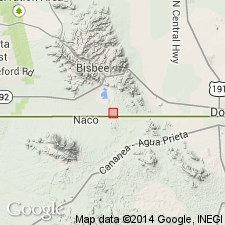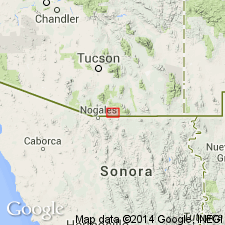
- Usage in publication:
-
- Molly Gibson formation
- Modifications:
-
- Original reference
- Dominant lithology:
-
- Clay
- Limestone
- AAPG geologic province:
-
- Basin-and-Range province
Summary:
Pg. 297 (table). Molly Gibson formation of Patagonia group. Named on table. Composed of gray arenaceous limestone and brown clay. Younger than Hay Flat limestone (new). Age is Early Cretaceous.
Source: US geologic names lexicon (USGS Bull. 1200, p. 2550).

- Usage in publication:
-
- Molly Gibson formation
- Modifications:
-
- Areal extent
- AAPG geologic province:
-
- Basin-and-Range province
Summary:
Pg. 30-31, 36 (table 6), pl. 2. Molly Gibson formation of Patagonia group. Composed mainly, and especially in lower part, of brown, gray, chocolate, and red argillaceous and siliceous shales. In upper part of formation are bluish limestone beds; thin and soft varicolored arenaceous and argillaceous shales; and soft and crumbly, light-gray and pinkish arenaceous limestone beds. Thickness 1,000 feet. In fault contact with Paleozoic strata, of which the American Peak is composed. Fossils (STOLICZKAIA SCOTTI, S. PATAGONICA, S. EXCENTRUMBLICATA). Age is Early Cretaceous (Albian); STOLICZKAIA DISPAR standard ammonite zone. Geographic area given.
Notable exposures near Molly Gibson Mine, between Harshaw and Mowry in Patagonia Mountains, Coronado National Forest, [Santa Cruz Co.], southeastern AZ.
Source: Publication; US geologic names lexicon (USGS Bull. 1200, p. 2550).

- Usage in publication:
-
- Molly Gibson Formation
- Modifications:
-
- Not used
Summary:
Not used in Patagonia Mountains, Basin-and-Range province because poorly described. Type locality only vaguely identified, the name does not appear on any published map of area, and fossils on which age assignment is based are too poorly preserved to be diagnostic.
Source: GNU records (USGS DDS-6; Denver GNULEX).
For more information, please contact Nancy Stamm, Geologic Names Committee Secretary.
Asterisk (*) indicates published by U.S. Geological Survey authors.
"No current usage" (†) implies that a name has been abandoned or has fallen into disuse. Former usage and, if known, replacement name given in parentheses ( ).
Slash (/) indicates name conflicts with nomenclatural guidelines (CSN, 1933; ACSN, 1961, 1970; NACSN, 1983, 2005, 2021). May be explained within brackets ([ ]).

